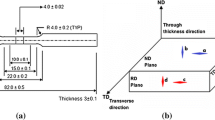A comparative study of chemical composition, structure, and mechanical properties (Rockwell hardness, HRC) is conducted for pseudo-β-titanium alloys for structural purposes (VT47, VT35, Timet LCB) after isothermal ageing over wide ranges of temperature and exposure times. Diagrams are plotted providing summarized hardness values for VT47 and Timet LCB alloys. Dependencies are revealed between hardness of these alloys and their alloying level with β-stabilizing elements as well as features of phase and structural transformations. “Incubation” periods are established for an increase in hardness in the temperature range studied and comparative evaluation of these periods is provided.




Similar content being viewed by others
Notes
[Mo]equ calculated by an equation, wt.%: [Mo]equ = 1.0Mo + 0.67V + 0.44W + 0.28Nb + 0.22Ta + 2.9Fe + 1.6Cr + 1.25Ni + 1.7Mn + 1.7Co.
References
S. L. Nyakana, J. C. Fanning, and R. R. Boyer, “Quick reference guide for β titanium alloys in the 00s,” J. of Materials Engineering and Performance, 14, No. 6, 799–811 (2005).
R. R. Boyer and R..D. Briggs, “The use of β titanium alloys in the aerospace industry,” J. of Materials Engineering and Performance, 14, No. 6, 681–685 (2005).
C. Leyens and M. Peters (editors), Titanium and Titanium Alloys. Fundamentals and Applications, Wiley–VCH, Germany (2003).
E. N. Kablov “Innovative development of FGUP VIAM GITs RF for implementing “Strategic areas of development of materials and preparation technology for the period to 2030,” Aviats. Mater. Technol., No. 1, 3–33 (2015); DOI: https://doi.org/10.18577/2071-9140-2015-0-1-3-33.
E. N. Kablov, “Marketing materials science, aircraft building and industry: present and future,” Direktor po Marketingu i Sbytu, No. 5-6, 4–44 (2017.
E. N. Kablov, N. A. Nochovnaya, A. A. Shiryaev, and Yu. A. Gribkov, RF Patent 2569285, 2014153690/02. High Strength Ally Based on Titanium and Object Made from High-Strength Alloy Based on Titanium, Claim 12.29.2014; Publ. 11.20.2015. Bull. No. 32.
E. N. Kablov, N. A. Nochovnaya, Yu. A. Gribkov, and A. A. Shiryaev, “Development of high-strength titanium pseudo-β -alloy and preparation of semiproducts from it,” Voprosy Materialoved., No. 3(87), 23–31 (2016).
A. A. Skupov, M. D. Panteleev, E. N. Ioda, and D. A. Movenko, “Efficiency of using rare-earth metals for alloying additive materials,” Aviats. Mater. Tekhnol., No. 3, 14–19 (2017); DOI: https://doi.org/10.18577/2071-9140-20170-3-14-19.
A. A. Shiryaev, and N. A. Nochovnaya, “Study of structure during ageing of high-strength pseudo-β -titanium alloy VT47,” Metallurg, No. 9, 76–84 (2019).
A. A. Shiryaev, N. A. Nochovnaya, and A. S. Pomel’nikova, “Effect of isothermal soaking on change in hardness of high-strength pseudo-β-titanium alloy VT47,” Trudy VIAM: Elektron. Nauch.-Tekhn. Zh., No. 10, Art. 3 (2019); URL: http://www.viam-works.ru (access date 03.14. 2020); DOI: https://doi.org/10.18577/2307-6046-2019-0-10-25-33.
A. A. Shiryaev, Effect of Rare Earth Elements and Thermomechanical Treatment Parameters on Structure, Phase Composition, and Mechanical Properties of Semifinished Sheet of High-Strength Pseudo-β -Titanium Alloy, Diss. Cand. Techn. Sci., Moscow (2019).
N. I. Moder, V. N. Moiseev, A. I. Antipov, A. K. Bezrukova, and L. M. Sukhorosova, “Transformation during isothermal treatment of pseudo-β-titanium alloy VT35,” Metalloved. Term. Obrab. Metallov., No. 3, 22–25 (1992).
S. Azimzadeh and H. J. Rack, “Phase transformations in Ti– 6.8Mo–4.5Fe–1.5Al,” Metallurgical and Materials Transactions A, 29A, 2455–2467 (1998).
V. V. Tetyukhin, Yu. A. Gribkov, N. I. Moder, and V. F. Vodolazskii, “Study of the structure and phase transformations in alloy VT35 during thin sheet manufacture,” Titan, No. 1(9), 25–29 (1996).
P. A. Golovkin and S. A. Fesenko, “Control of deformation as a tool providing a prescribed structure and properties of titanium alloy forgings,” Tekhnol. Mashin., No. 8, 15–19 (2008).
E. I. Oreshko, D. A. Utkin, V. S. Erasov, and A. A. Lyakhov, “Methods fr measuring material hardness (review),” Trudy VIAM: Élektron, Nauch. Tekhn. Zh., No. 1, Art. 10 (2020); URL: http://www.viam-works.ru (access date 03.14.2020); DOI: https://doi.org/10.18577/23076046-2020-0-1-101-117.
S. M. Illarionova, O. A. Elkina, and A. G. Illarionov, “Phase transformation in metastable β -solid solution during heat treatment of pseudo-β -titanium alloy with REM,” Titan, No 3, 14–18 (2016).
R. P. Kolli and A. Devaraj, “A review of metastable beta titanium alloys,” Metals, 8, No. 7, 506 (2018).
J. D. Cotton, R. D. Briggs, R. R. Boyer, S. Tamirisakandala, P. Russo, N. Shchetnikov, and J. C. Fanning, “State of the art in beta titanium alloys for airframe applications,” JOM, 67, No. 6, 1281–1303 (2015).
P. Schmidt, A. El-Chaikh, and H.-J. Christ, “Effect of duplex aging on the initiation and propagation of fatigue cracks in the soluterich metastable β titanium alloy Ti 38-644,” Metallurgical And Materials Transactions A, 42A, 2652–2667 (2011).
S. Azimzadeh, Phase Transformations in Metastable β Titanium Alloy TIMET LCB (Ti–6.8Mo–4.5Fe–1.5Al, Master of Science Thesis, Clemson University, Clemson, SC, December (1995).
J. Kiese, W. Walz, and B. Skrotzki, Influence of Heat Treatment and Shot Peening on Fatigue Behavior Pf Suspension Springs Made of Timetal LCB, Proc. of 10th World Conference on Titanium “Ti– 2003 Science and Technology”. Wiley–VCH, Germany (2004).
B. Koch and B. Skrotzki, “Strain controlled fatigue testing of the metastable β -titanium alloy Ti–6.8Mo–4.5Fe–1.5Al (Timetal LCB),” Materials Science and Engineering A, 528, 5999– 6005 (2011).
P. E. Markovskyi and M. Ikeda, “Influence of alloying elements on the aging of economically alloyed metastable titanium betaalloys,” Material Science, 49, No. 1, 85–92 (2013).
Author information
Authors and Affiliations
Corresponding author
Additional information
Translated from Metallurg, Vol. 64, No. 10, pp. 65–73, October, 2020.
Rights and permissions
About this article
Cite this article
Duyunova, V.A., Nochovnaya, N.A. & Shiryaev, A.A. Comparative Study of the Effect of Isothermal Exposure on Metastable β-Titanium Alloy Mechanical Properties. Metallurgist 64, 1057–1067 (2021). https://doi.org/10.1007/s11015-021-01087-z
Received:
Published:
Issue Date:
DOI: https://doi.org/10.1007/s11015-021-01087-z




